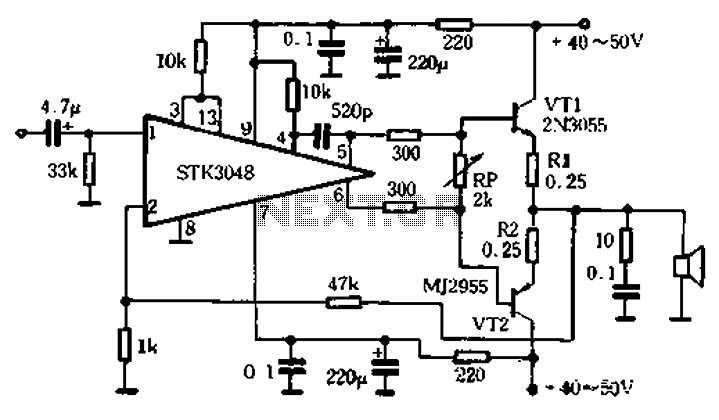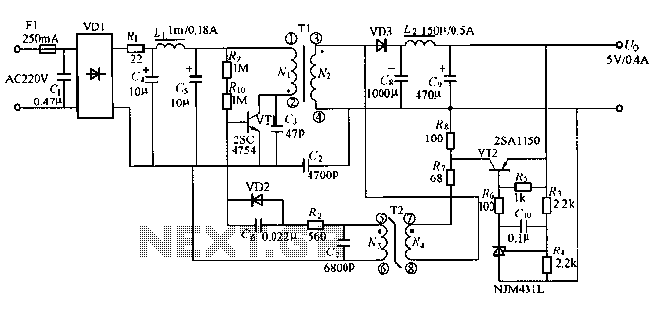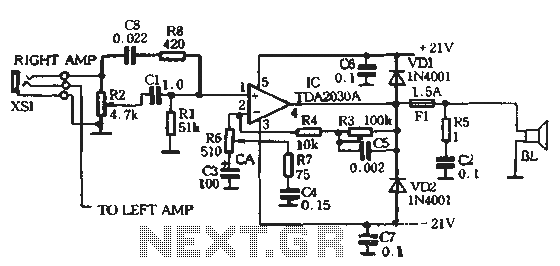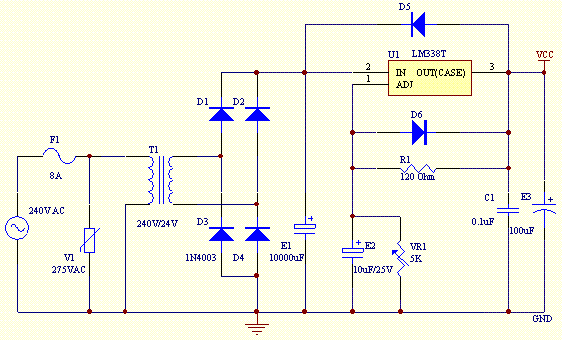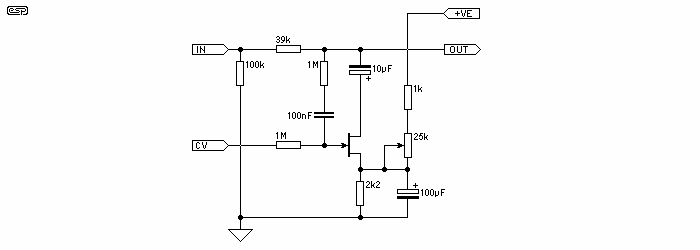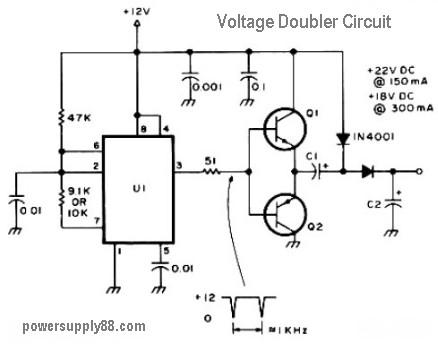
adjustable current limiter circuit

This circuit is designed to provide automatic current limiting up to 8.4 A. Unlike traditional current limiters that rely solely on a resistor, this circuit minimizes voltage drop until a specified current threshold is exceeded. The current limit can be adjusted from 1.4 A to 8.4 A using a potentiometer. The component values can be modified to achieve different current limiting ranges.
The circuit operation begins with resistor R1, which senses the current. When the potentiometer R2 is set to its minimum resistance (with the center tap connected to R1), if the load current reaches 1.2 A, the voltage across R1 will reach 0.6 V, causing transistor Q2 to conduct. This action shorts the base voltage of transistor Q4 to ground, reducing the base current and consequently lowering the output voltage sensed by the load, thereby preventing further current flow. For lower current limiting thresholds, R1 can be changed to 1 Ω, providing an adjustment range of approximately 0.7 A to 4.2 A.
Due to the power dissipation capabilities of the 2N3055 transistor, in the worst-case scenario where the load is shorted to ground (zero resistance), the circuit can handle a maximum source voltage of 14 V while limiting the current to 8.4 A. Conversely, limiting the current to 4.2 A allows for a maximum source voltage of 27 V. The circuit can withstand a maximum voltage of 60 V, but under extreme conditions (load shorted to ground), the current limit should be set to a safe maximum of 1.9 A. It is essential for transistor Q1 to be equipped with an adequate heat sink.
The circuit utilizes a combination of resistors, potentiometers, and transistors to achieve its current limiting functionality. The configuration allows for flexibility in current settings and ensures that the load does not exceed the specified limits, thereby protecting both the power supply and the connected devices. The careful selection of components and their arrangement in the circuit is crucial for achieving reliable performance and maintaining safe operating conditions.This circuit is design for provide automatic current limiting up to 8. 4A. Unlike current limiter that uses only a resistor, this current limiting circuit doesn`t drop the voltage, or at least keep the voltage drop at minimum, until a certain current amount is exceeded. This current amount limit is adjustable from 1. 4 A to 8. 4A by a potentiometer. You can modify the component value to give different current limiting range. This is the simple figure of the circuit. How is the circuit work First, the resistor R1 is there to sense the current. At R2 potentiometer at minimum resistance (the center tap connected to R1), if the current drawn by the load reach 1. 2A then the voltage across R1 reach 0. 6V and Q2 begin conducting, thus shorting the base voltage of Q4 to ground. This shorting action to reduces the base current and therefore reduce the output voltage sensed by the load, and prevent the current to flow further.
If you need the current limiter to limit at lower threshold range, you can change the R1 to 1R and you`ll get about 0. 7A to 4. 2A adjustment range. Because of the power dissipation capability of 2N3055 transistor, at the worst case that the load is shorted to ground (zero resistance), when you limit the current to 8.
4 A then the circuit can handle maximum source voltage of 14V, while limiting the current at 4. 2A can handle up to 27V source voltage. The maximum voltage that can be handled the circuit is 60 volt, but you can only safely set the current limit at 1. 9A in the extreme condition, when the load is shorted to ground. The Q1 transistor must use sufficient heat sink. [Schematic project source: Hasan Murod]. 🔗 External reference
The circuit operation begins with resistor R1, which senses the current. When the potentiometer R2 is set to its minimum resistance (with the center tap connected to R1), if the load current reaches 1.2 A, the voltage across R1 will reach 0.6 V, causing transistor Q2 to conduct. This action shorts the base voltage of transistor Q4 to ground, reducing the base current and consequently lowering the output voltage sensed by the load, thereby preventing further current flow. For lower current limiting thresholds, R1 can be changed to 1 Ω, providing an adjustment range of approximately 0.7 A to 4.2 A.
Due to the power dissipation capabilities of the 2N3055 transistor, in the worst-case scenario where the load is shorted to ground (zero resistance), the circuit can handle a maximum source voltage of 14 V while limiting the current to 8.4 A. Conversely, limiting the current to 4.2 A allows for a maximum source voltage of 27 V. The circuit can withstand a maximum voltage of 60 V, but under extreme conditions (load shorted to ground), the current limit should be set to a safe maximum of 1.9 A. It is essential for transistor Q1 to be equipped with an adequate heat sink.
The circuit utilizes a combination of resistors, potentiometers, and transistors to achieve its current limiting functionality. The configuration allows for flexibility in current settings and ensures that the load does not exceed the specified limits, thereby protecting both the power supply and the connected devices. The careful selection of components and their arrangement in the circuit is crucial for achieving reliable performance and maintaining safe operating conditions.This circuit is design for provide automatic current limiting up to 8. 4A. Unlike current limiter that uses only a resistor, this current limiting circuit doesn`t drop the voltage, or at least keep the voltage drop at minimum, until a certain current amount is exceeded. This current amount limit is adjustable from 1. 4 A to 8. 4A by a potentiometer. You can modify the component value to give different current limiting range. This is the simple figure of the circuit. How is the circuit work First, the resistor R1 is there to sense the current. At R2 potentiometer at minimum resistance (the center tap connected to R1), if the current drawn by the load reach 1. 2A then the voltage across R1 reach 0. 6V and Q2 begin conducting, thus shorting the base voltage of Q4 to ground. This shorting action to reduces the base current and therefore reduce the output voltage sensed by the load, and prevent the current to flow further.
If you need the current limiter to limit at lower threshold range, you can change the R1 to 1R and you`ll get about 0. 7A to 4. 2A adjustment range. Because of the power dissipation capability of 2N3055 transistor, at the worst case that the load is shorted to ground (zero resistance), when you limit the current to 8.
4 A then the circuit can handle maximum source voltage of 14V, while limiting the current at 4. 2A can handle up to 27V source voltage. The maximum voltage that can be handled the circuit is 60 volt, but you can only safely set the current limit at 1. 9A in the extreme condition, when the load is shorted to ground. The Q1 transistor must use sufficient heat sink. [Schematic project source: Hasan Murod]. 🔗 External reference
